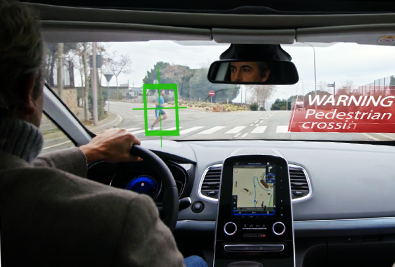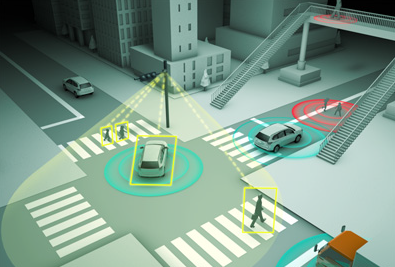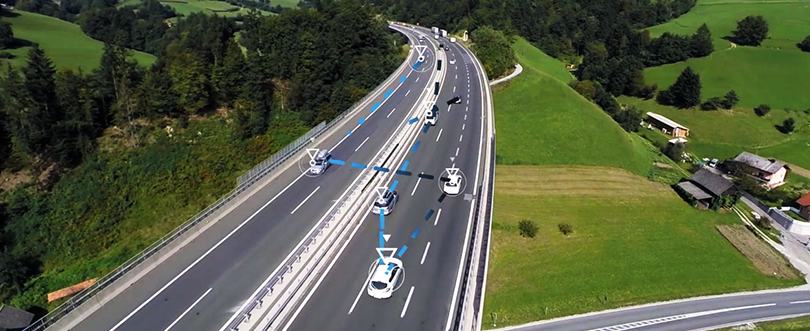Bringing Personal Safety to our Driving Society - Supporting safe and secure driving
Bringing Personal Safety to our Driving Society - Supporting safe and secure driving
Automotive safety equipment evolves each year, making our driving safer and more secure. As communication technology advances rapidly, public systems as a whole have begun working to increase the safety of automobiles, as well.
Panasonic is researching and developing solutions to make driving safer and more secure, including highly-developed sensing and image recognition technologies, as well as collaboration with network infrastructure to transmit easily-understood information to the user.
Automotive safety equipment evolves each year, making our driving safer and more secure. As communication technology advances rapidly, public systems as a whole have begun working to increase the safety of automobiles, as well.
Panasonic is researching and developing solutions to make driving safer and more secure, including highly-developed sensing and image recognition technologies, as well as collaboration with network infrastructure to transmit easily-understood information to the user.


Increasing safety consciousness
Increasing safety consciousness

These days, Advanced Driver Assistance Systems (ADAS) are rapidly adopted in cars. These systems utilize information from cameras and sensors to support accident prevention and collision avoidance. Recently, many car manufacturers have made great efforts toward the development of functions to prevent accidents before they even happen, such as collision prevention sensors, automatic brakes functions, and automatic driver-assist. Now, these functions are being adopted as standard features.
Utilizing its strengths in cameras and sensing technology, as well as image analysis technology, Panasonic will continue to promote the development of ADAS.
These days, Advanced Driver Assistance Systems (ADAS) are rapidly adopted in cars. These systems utilize information from cameras and sensors to support accident prevention and collision avoidance. Recently, many car manufacturers have made great efforts toward the development of functions to prevent accidents before they even happen, such as collision prevention sensors, automatic brakes functions, and automatic driver-assist. Now, these functions are being adopted as standard features.
Utilizing its strengths in cameras and sensing technology, as well as image analysis technology, Panasonic will continue to promote the development of ADAS.
Three factors that support safety
Three factors that support safety
ADAS senses the surrounding situation, assesses its danger, and controls the automobile as necessary. It is crucial to achieve these three functions at a high level.
ADAS development at Panasonic takes advantage of the Panasonic Group’s comprehensive technology assets and advanced technology. High-performance sensing devices like drive camera modules and ultrasonic sensors allow more information to be sensed. With that sensed information and the use of Panasonic’s image analysis technology developed in the digital A/V field (security cameras, etc.), more accurate assessments become possible. If the situation is assessed to be dangerous, the reliability established in ECU development supports control of the automobile.
ADAS senses the surrounding situation, assesses its danger, and controls the automobile as necessary. It is crucial to achieve these three functions at a high level.
ADAS development at Panasonic takes advantage of the Panasonic Group’s comprehensive technology assets and advanced technology. High-performance sensing devices like drive camera modules and ultrasonic sensors allow more information to be sensed. With that sensed information and the use of Panasonic’s image analysis technology developed in the digital A/V field (security cameras, etc.), more accurate assessments become possible. If the situation is assessed to be dangerous, the reliability established in ECU development supports control of the automobile.

As research and development of high-performance sensing and assessing technology, Panasonic is engaged in development of technology to detect people and vehicles in images, using deep learning. High-resolution, high-speed detection will be possible even in environments crowded with people and vehicles, such as intersections.
As research and development of high-performance sensing and assessing technology, Panasonic is engaged in development of technology to detect people and vehicles in images, using deep learning. High-resolution, high-speed detection will be possible even in environments crowded with people and vehicles, such as intersections.
Further improvement of safety through communication technology
Further improvement of safety through communication technology
Network connectivity with automobiles is predicted to continue. In preparation for that near future, Panasonic is utilizing its networking and IT technology to achieve an unprecedented level of safety.
Network connectivity with automobiles is predicted to continue. In preparation for that near future, Panasonic is utilizing its networking and IT technology to achieve an unprecedented level of safety.

One of the key technologies to an ITS society is V2X (Vehicle-to-Everything). V2X uses wireless communication to collect information from oncoming vehicles and local infrastructure which would be difficult to detect from only one’s own car. This includes information about traffic congestion and collision/contact danger, reducing the risk of traffic jams and accidents before they happen.
One of the key technologies to an ITS society is V2X (Vehicle-to-Everything). V2X uses wireless communication to collect information from oncoming vehicles and local infrastructure which would be difficult to detect from only one’s own car. This includes information about traffic congestion and collision/contact danger, reducing the risk of traffic jams and accidents before they happen.
Panasonic is developing V2V technology, which sends signals between vehicles, V2I technology, which sends signals between vehicles and infrastructure, and V2P technology, which sends signals between vehicles and pedestrians. By demonstrating their success in various fields inside and outside Japan, Panasonic is actively engaged in the practical application of these new technologies.
Panasonic is developing V2V technology, which sends signals between vehicles, V2I technology, which sends signals between vehicles and infrastructure, and V2P technology, which sends signals between vehicles and pedestrians. By demonstrating their success in various fields inside and outside Japan, Panasonic is actively engaged in the practical application of these new technologies.
ITS Solutions to support safety in broader fields
ITS Solutions to support safety in broader fields
Intelligent Transportation Systems are next-generation transportation systems making progress in countries around the world. They organically connect people, cars, and streets in traffic environments, and aim to make transportation safe and comfortable everywhere.
Panasonic is one of the few manufacturers handling fields ranging all the way from automotive devices and systems to traffic infrastructure. Utilizing its comprehensive expertise, Panasonic is researching and developing the solutions necessary to make ITS a reality.
Intelligent Transportation Systems are next-generation transportation systems making progress in countries around the world. They organically connect people, cars, and streets in traffic environments, and aim to make transportation safe and comfortable everywhere.
Panasonic is one of the few manufacturers handling fields ranging all the way from automotive devices and systems to traffic infrastructure. Utilizing its comprehensive expertise, Panasonic is researching and developing the solutions necessary to make ITS a reality.

One example of the implementation of ITS is the ETC (electronic toll collection system) with which toll roads and highways are equipped. ETCs are effective at improving the traffic environment by providing information around the toll booth in order to alleviate traffic congestion and support safe driving. Panasonic has contributed to the maintenance and popularization of not just ETC equipment for cars, but also the infrastructure equipment of toll booths and other facilities.
Moving forward, Panasonic will continue to utilize the high-level IT technology strength it has developed in the information analysis field to analyze big data collected from moving vehicles, and provide drivers with information to help them drive safely.
One example of the implementation of ITS is the ETC (electronic toll collection system) with which toll roads and highways are equipped. ETCs are effective at improving the traffic environment by providing information around the toll booth in order to alleviate traffic congestion and support safe driving. Panasonic has contributed to the maintenance and popularization of not just ETC equipment for cars, but also the infrastructure equipment of toll booths and other facilities.
Moving forward, Panasonic will continue to utilize the high-level IT technology strength it has developed in the information analysis field to analyze big data collected from moving vehicles, and provide drivers with information to help them drive safely.

Panasonic is a full member of the NPO ITS Japan, which promotes ITS in a cooperation between industry, government, and schools. Through partnership and coordination with industry, government, and scholastic organizations which share the same goal, Panasonic is actively working toward a society with safer and more comfortable driving environments.
Panasonic is a full member of the NPO ITS Japan, which promotes ITS in a cooperation between industry, government, and schools. Through partnership and coordination with industry, government, and scholastic organizations which share the same goal, Panasonic is actively working toward a society with safer and more comfortable driving environments.

